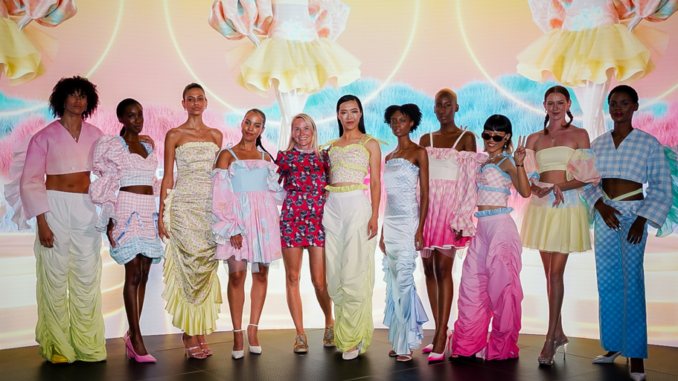
[ad_1]
Fashion week celebrations aren’t all about the physical anymore. Technology has added a much-needed freshness to London Fashion Week, not to mention a space for young talent. By extending creativity into the boundless digital domain, fashion now breathes with inclusivity, creative freedom, and excitement over the possibilities ahead.
Last year, traditional brands went all in Web3, betting on NFTs and other activations. This year, a clear divide has emerged between traditional maisons and digital fashion innovators. It appears that prominent brands are taking a step back from the hype to answer critical questions about the role of emerging tech in the future of fashion—but independent designers and upstarts continue to push forward.
Stepping into the office of Epic Games London, which hosted this year’s Digital Fashion Week, I was greeted by an immaculate 3D avatar goddess of a model. For a fleeting moment, I questioned her reality—but soon realized that such flawless skin is impossible in the physical world. That was my first encounter with one of Epic’s MetaHuman creations. Later, I’d find out that this high-fidelity digital person is also a DJ!
The venue buzzed with energy as attendees mingled amidst screens streaming out-of-this-world digital designs. Ahead of panel discussions, I made a quick round of greeting fellow attendees who showcased the vibe that would be on display—some rocking 3D-printed face masks and other fashion-forward outfits, setting the tone.
While professional NFT conference attendees continued to prophesize the impending disruption of fashion, others maintained a more measured stance about the opportunities ahead.
They referenced data points and shared strategies that influential legacy fashion houses are meticulously crafting around Web3 tech. Demi Karanikolau, Amazon’s head of luxury partnerships, hinted at a plethora of activity behind the scenes—from data analysis to the strategic build-out of infrastructure, all geared towards the gradual integration of technology into fashion.
One notable trend, highlighted by one of the most stylish and influential figures in digital fashion, Tracy Greenan—a serial entrepreneur and founder of Aura and Gamers Over Guns—is the surge in overlap between fashion and gaming. The most gifted designers are now readily found on platforms like Roblox, paving the way for fashion brands to create new experiences and revenue streams alike.
But the optimism and excitement were tempered by caution. After the turbulence of the past year—from the collapses of Terra and FTX to NFT projects that cratered or did not deliver—many who are building in the digital realm have adopted a more reserved stance, carefully watching for who is going to make the next big move.
Even so, as Digital Fashion Week attendees returned for the second day—which was dedicated to fashion shows—it was easy to get caught up in the creative frenzy.
As I strategically occupied a perfect spot to watch MetaHumans in surreal ephemeral designs on large screens, I was very much caught by surprise when I saw human models marching amongst them and forming an improvised runway.
I recognized the patterns and color schemes of digital atelier Blanc de Blanc in the clothes. Runway shows by Olska Green and Stephy Fung followed.
The most famous digital fashion designers, who have been creating in the CLO3D software for the past few years, are now moving back into the physical realm. And they’re bringing along the best tools—from sustainable and efficient production technologies to AR filters and impressive 3D videos.
It felt like a ray of light shined the path forward for the very probable future of fashion, where physical designs will be created by digital native designers—and technology will merge two parallels into one hopefully better fashion industry.
It’s impossible to overlook the fact that London has outshone New York in terms of the scale and number of digital fashion events. The British capital, typically more conservative and reserved, took everyone by surprise this year.
Alice Delahunt, former Ralph Lauren executive and founder of Syky, seamlessly merged traditional fashion with the digital world, delivering a captivating blend of opulent parties and unwavering professionalism. Syky’s London event left even the most discerning socialites in awe, boasting massive screens and showcasing 3D-printed designs by the talented Felipe Fiallo. The presentations by Stephy Fung and Fanrui Sun were nothing short of impressive and brimming with promise.
While it’s evident that many major brands have taken a significant step back from the Web3 realm, especially when compared to their previous fervor the past couple of years, digital-native designers are emerging as the new disruptors, injecting much-needed tech innovation into the world of haute couture.
Stay on top of crypto news, get daily updates in your inbox.
[ad_2]
Source link




